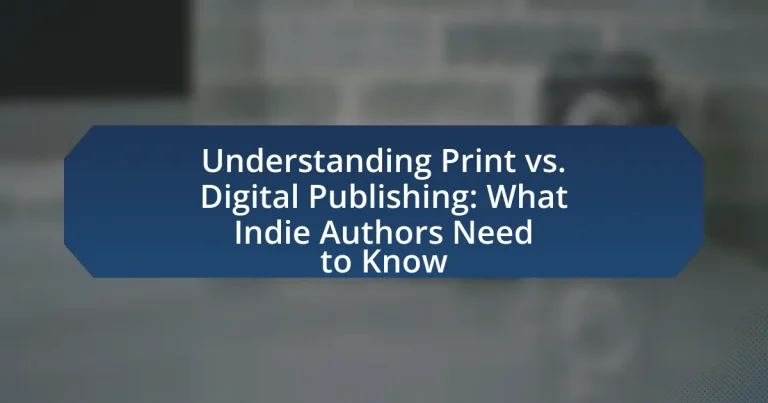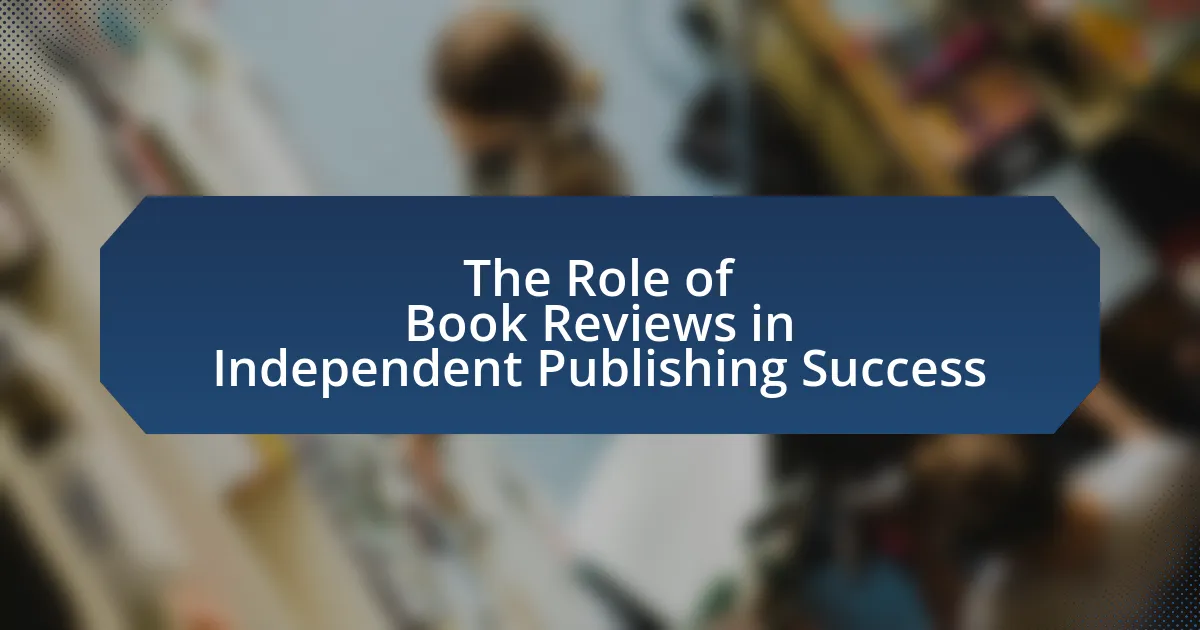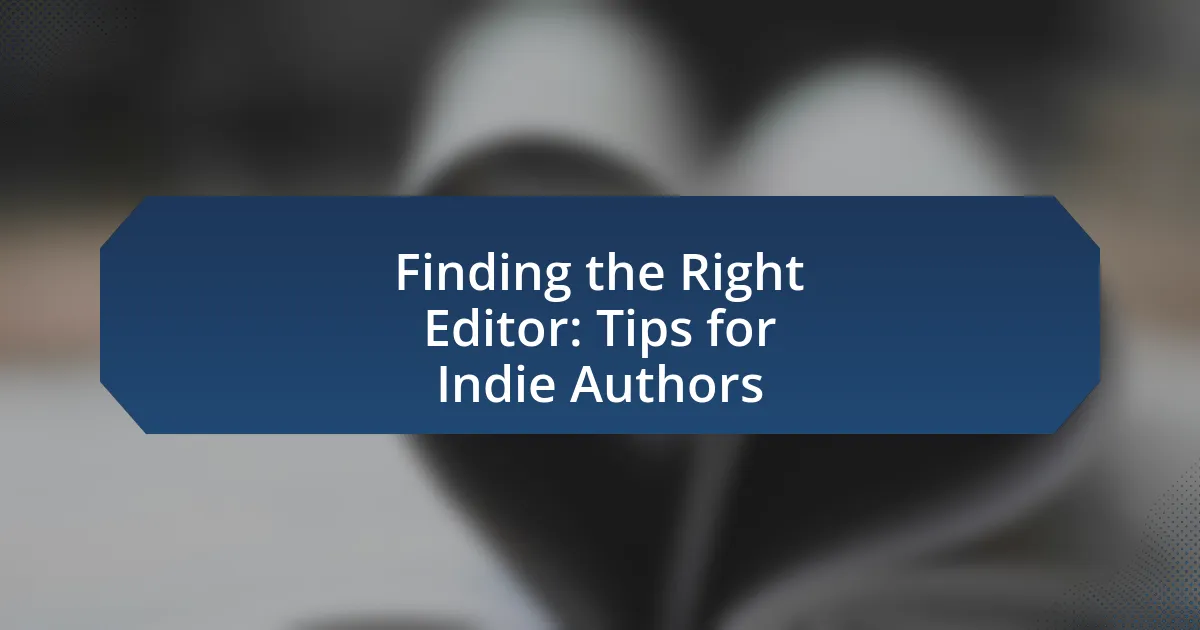The article “Understanding Print vs. Digital Publishing: What Indie Authors Need to Know” provides a comprehensive analysis of the differences between print and digital publishing, emphasizing their distinct characteristics, advantages, and disadvantages. It explores how these formats impact audience reach, engagement, and marketing strategies, particularly for indie authors. Key topics include the importance of understanding both formats for maximizing sales potential, the influence of target audience preferences on format choice, and strategies for effectively combining print and digital publishing to enhance visibility and reader engagement. The article serves as a valuable resource for indie authors navigating the evolving landscape of publishing.
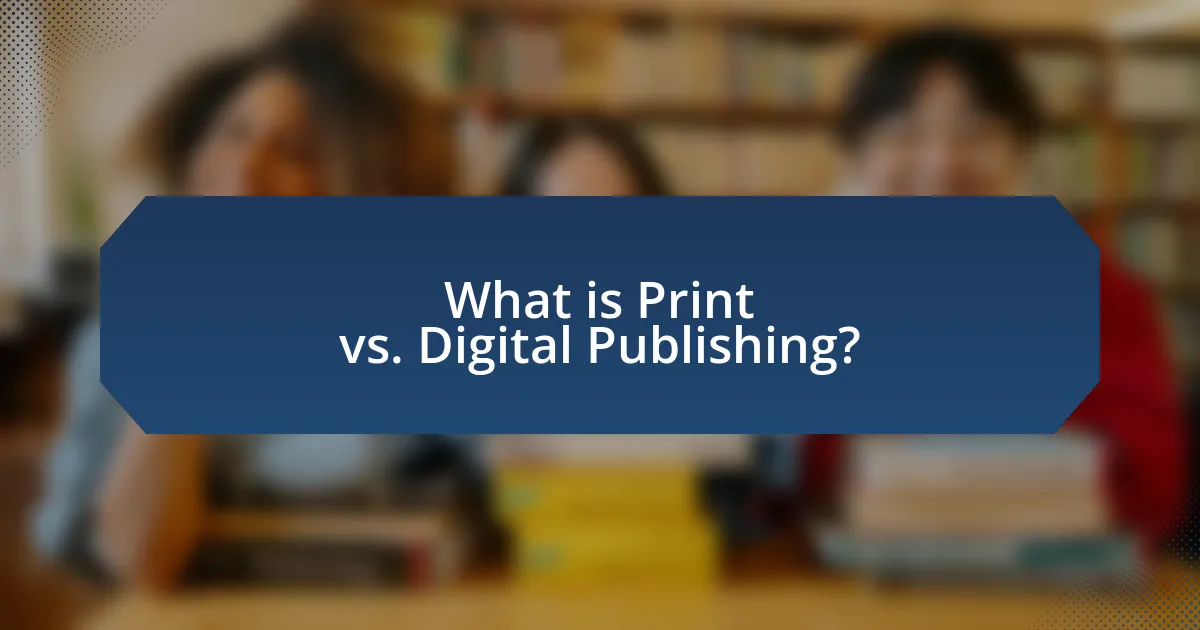
What is Print vs. Digital Publishing?
Print publishing involves the production of physical books, magazines, or other materials that are tangible and can be distributed in physical formats. Digital publishing, on the other hand, refers to the creation and distribution of content in electronic formats, such as eBooks, online articles, and digital magazines. The primary distinction lies in the medium; print publishing requires physical materials and printing processes, while digital publishing utilizes electronic platforms for distribution. According to the Association of American Publishers, digital book sales have consistently increased, indicating a significant shift in consumer preference towards digital formats, which often offer advantages like lower production costs and wider distribution reach.
How do print and digital publishing differ in format?
Print and digital publishing differ primarily in their physical and interactive formats. Print publishing involves tangible materials such as books, magazines, and newspapers, which require physical distribution and storage. In contrast, digital publishing encompasses electronic formats like eBooks, online articles, and PDFs, which can be accessed on various devices such as computers, tablets, and smartphones. The transition from print to digital has led to changes in design elements, such as the ability to incorporate multimedia content in digital formats, enhancing reader engagement. Additionally, digital publishing allows for real-time updates and distribution, unlike print, which is static once produced.
What are the key characteristics of print publishing?
The key characteristics of print publishing include tangible format, fixed layout, and physical distribution. Print publishing produces physical copies of books, magazines, or newspapers, which allows readers to engage with a tangible product. The fixed layout ensures that the design and formatting remain consistent across all copies, providing a uniform reading experience. Additionally, print publishing relies on physical distribution channels, such as bookstores and libraries, which can enhance visibility and accessibility for readers. These characteristics distinguish print publishing from digital formats, which offer different engagement and distribution methods.
What are the defining features of digital publishing?
The defining features of digital publishing include accessibility, interactivity, and multimedia integration. Accessibility allows readers to access content on various devices, such as smartphones, tablets, and computers, enhancing reach and convenience. Interactivity enables user engagement through features like hyperlinks, embedded videos, and interactive graphics, which can enhance the reading experience. Multimedia integration allows the incorporation of text, images, audio, and video, providing a richer and more dynamic presentation of information. These features collectively differentiate digital publishing from traditional print publishing, which is limited to static text and images.
Why is understanding both formats important for indie authors?
Understanding both print and digital formats is crucial for indie authors because it allows them to effectively reach diverse audiences and maximize their sales potential. Print formats cater to readers who prefer physical books, while digital formats appeal to those who favor e-readers and online platforms. According to a 2021 report by the Association of American Publishers, e-book sales accounted for 20% of the total book market, highlighting the significance of digital formats. Additionally, understanding the nuances of both formats enables indie authors to make informed decisions about pricing, distribution, and marketing strategies, ultimately enhancing their chances of success in a competitive publishing landscape.
How can knowledge of both formats influence an author’s strategy?
Knowledge of both print and digital publishing formats can significantly influence an author’s strategy by enabling them to tailor their content and marketing approaches to diverse audiences. Understanding the strengths and weaknesses of each format allows authors to choose the most effective medium for their target demographic; for instance, print may appeal more to traditional readers who value physical books, while digital formats can reach tech-savvy audiences seeking convenience and accessibility. Additionally, authors can optimize their pricing strategies based on format-specific market trends, such as the higher production costs associated with print versus the lower overhead of digital publishing. This strategic awareness can lead to increased sales and broader readership engagement, as evidenced by the rise in self-publishing success stories where authors leverage both formats to maximize their reach and revenue.
What are the potential impacts on audience reach and engagement?
The potential impacts on audience reach and engagement are significant differences between print and digital publishing. Digital publishing typically allows for a broader audience reach due to the global accessibility of online platforms, enabling indie authors to connect with readers worldwide. In contrast, print publishing often limits reach to local or regional markets, as physical distribution can be constrained by logistics and costs.
Engagement levels also vary; digital formats can incorporate interactive elements such as hyperlinks, multimedia content, and social sharing options, which enhance reader interaction and retention. According to a study by the Pew Research Center, 72% of adults in the U.S. read e-books, indicating a strong preference for digital formats that can foster higher engagement through features like instant feedback and community discussions.
In summary, digital publishing generally offers greater audience reach and enhanced engagement opportunities compared to traditional print publishing.
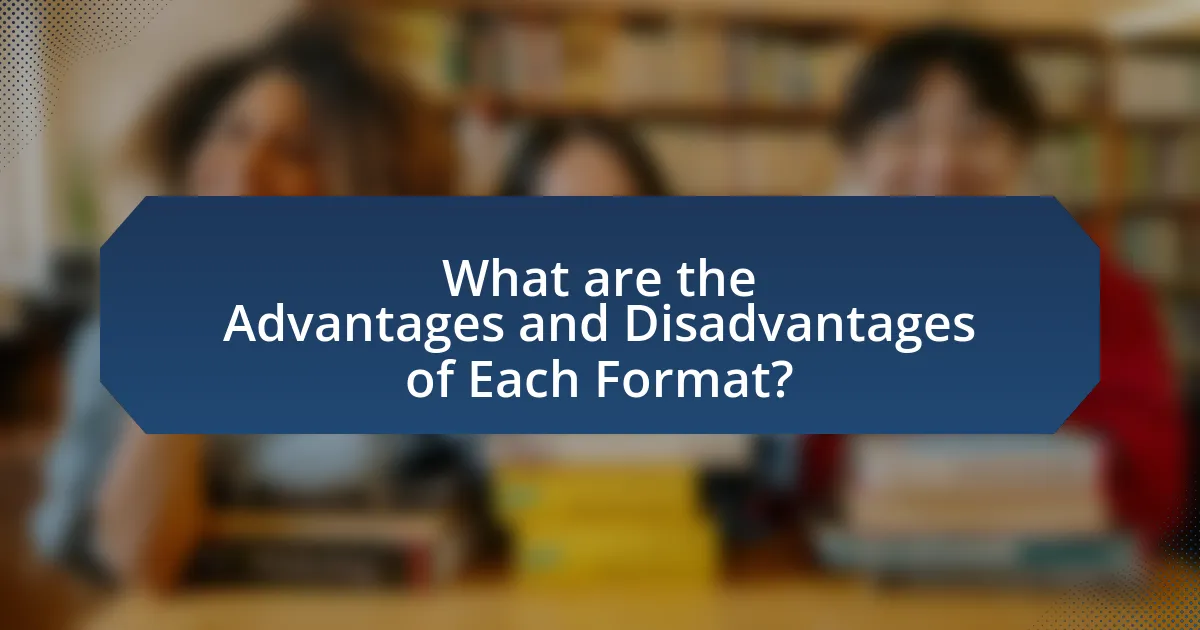
What are the Advantages and Disadvantages of Each Format?
Print publishing offers advantages such as tangible products that can be sold in physical stores and a perceived higher value among readers, which can enhance credibility for indie authors. However, it has disadvantages including higher production costs, limited distribution channels, and the need for physical inventory management.
Digital publishing provides benefits like lower production costs, instant distribution, and the ability to reach a global audience without geographical limitations. Conversely, it faces challenges such as market saturation, reliance on technology, and potential issues with digital rights management.
What are the benefits of print publishing for indie authors?
Print publishing offers indie authors several key benefits, including increased credibility, tangible presence, and broader market reach. Credibility is enhanced as print books are often perceived as more professional compared to digital formats, which can help authors establish authority in their genre. A tangible presence allows readers to physically hold and browse the book, which can lead to higher sales in bookstores and at events. Additionally, print books can reach audiences who prefer physical copies, expanding the author’s market beyond digital readers. According to a 2021 survey by the Book Industry Study Group, 65% of readers still prefer print books, highlighting the ongoing demand for physical formats.
How does print publishing enhance credibility and tangibility?
Print publishing enhances credibility and tangibility by providing a physical format that readers can hold and interact with, which often leads to a perception of higher quality and trustworthiness. Research indicates that consumers tend to view printed materials as more reliable than digital content; for instance, a study by the Pew Research Center found that 80% of respondents believed print media is more credible than online sources. Additionally, the tactile experience of print—such as the feel of the paper and the visual layout—creates a sense of permanence and authenticity that digital formats often lack. This physical presence reinforces the author’s commitment to their work, further establishing credibility in the eyes of the audience.
What are the sales and distribution advantages of print books?
Print books have significant sales and distribution advantages, primarily due to their tangible nature and established retail channels. The physical presence of print books allows for in-store displays, which can attract impulse buyers, leading to higher sales volumes. Additionally, print books benefit from a well-established distribution network that includes bookstores, libraries, and wholesalers, facilitating wider reach compared to digital formats. According to the Association of American Publishers, print book sales accounted for approximately 75% of the total book market in 2022, highlighting their continued popularity and market dominance. Furthermore, print books can be sold at events, such as author signings and book fairs, providing direct access to consumers and enhancing sales opportunities.
What are the drawbacks of print publishing?
The drawbacks of print publishing include high production costs, limited distribution, and environmental concerns. High production costs arise from expenses related to printing, binding, and shipping, which can significantly reduce profit margins for indie authors. Limited distribution is another issue, as print books often require physical retail space, making it challenging for authors to reach a wider audience compared to digital formats. Additionally, print publishing contributes to environmental concerns due to paper usage and waste, which is increasingly scrutinized in today’s eco-conscious market.
How do production costs affect indie authors in print publishing?
Production costs significantly impact indie authors in print publishing by determining their profit margins and pricing strategies. High production costs, which include expenses for printing, paper, and distribution, can lead to higher retail prices for books, making them less competitive in the market. For instance, if an indie author spends $5 to produce a book and sells it for $10, their profit is $5. However, if production costs rise to $8, the profit decreases to $2, limiting the author’s ability to invest in marketing or future projects. Additionally, according to a 2021 survey by the Alliance of Independent Authors, 70% of indie authors reported that managing production costs was a critical factor in their overall business strategy, highlighting the direct correlation between these costs and their financial viability.
What challenges do indie authors face with print distribution?
Indie authors face significant challenges with print distribution, primarily due to limited access to traditional distribution channels. Many indie authors struggle to secure shelf space in bookstores, as these retailers often prioritize established publishers. Additionally, indie authors may encounter high printing costs and logistical issues related to inventory management, which can hinder their ability to compete with larger publishers. According to a survey by the Independent Book Publishers Association, 70% of indie authors reported difficulties in reaching retail outlets, highlighting the systemic barriers they face in print distribution.
What are the benefits of digital publishing for indie authors?
Digital publishing offers indie authors increased accessibility, higher profit margins, and greater control over their work. Accessibility is enhanced as authors can reach global audiences instantly through platforms like Amazon Kindle and Smashwords, which eliminate geographical barriers. Higher profit margins are achieved because digital publishing typically incurs lower production and distribution costs compared to traditional print publishing, allowing authors to retain a larger percentage of sales revenue. Additionally, indie authors maintain creative control over their content, pricing, and marketing strategies, enabling them to adapt quickly to market trends and reader feedback. These benefits collectively empower indie authors to establish their presence in the literary market effectively.
How does digital publishing provide wider accessibility?
Digital publishing provides wider accessibility by allowing content to be distributed globally through the internet, eliminating geographical barriers. This format enables readers from diverse backgrounds and locations to access materials instantly, often at lower costs compared to traditional print publishing. For instance, eBooks can be downloaded on various devices, making literature available to individuals who may not have access to physical bookstores. Additionally, digital publishing supports features like adjustable text sizes and screen readers, enhancing usability for people with disabilities. According to a report by the Pew Research Center, 27% of Americans read eBooks in 2021, highlighting the growing trend and demand for accessible digital content.
What are the cost advantages of digital publishing?
Digital publishing offers significant cost advantages over traditional print publishing, primarily due to lower production and distribution expenses. For instance, digital formats eliminate the need for physical materials such as paper, ink, and printing equipment, which can reduce costs by up to 80% compared to print. Additionally, digital distribution through platforms like Amazon Kindle or Apple Books incurs minimal fees, allowing authors to reach a global audience without the overhead associated with shipping and inventory management. This streamlined process not only enhances profitability but also enables indie authors to invest more in marketing and promotion, further increasing their potential revenue.
What are the drawbacks of digital publishing?
The drawbacks of digital publishing include issues such as limited audience reach, potential for piracy, and reliance on technology. Limited audience reach occurs because not all readers prefer digital formats, which can restrict sales compared to print. Piracy poses a significant risk, as digital content can be easily copied and distributed without authorization, undermining authors’ revenue. Additionally, reliance on technology means that authors and readers must have access to devices and the internet, which can exclude certain demographics. These factors collectively highlight the challenges indie authors face in the digital publishing landscape.
How does digital publishing impact perceived value?
Digital publishing significantly impacts perceived value by enhancing accessibility and reducing costs for consumers. The ease of distribution through digital platforms allows indie authors to reach a wider audience, which can elevate the perceived value of their work due to increased visibility. Additionally, studies indicate that consumers often associate lower prices with lower quality; however, the convenience and immediacy of digital formats can counteract this perception, as seen in the rise of e-books, which accounted for 20% of the book market in 2020 according to the Association of American Publishers. This shift demonstrates that while digital publishing may lower the price point, it can simultaneously enhance perceived value through broader access and convenience.
What challenges do indie authors face in digital marketing?
Indie authors face several challenges in digital marketing, primarily due to limited resources and visibility. Many indie authors lack the budget for professional marketing services, which can hinder their ability to reach a broader audience. According to a survey by the Alliance of Independent Authors, 70% of indie authors report that marketing is their biggest challenge. Additionally, the saturated market makes it difficult for indie authors to stand out among numerous titles, leading to competition with established authors and traditional publishing houses. Furthermore, indie authors often struggle with the technical aspects of digital marketing, such as search engine optimization (SEO) and social media algorithms, which can limit their effectiveness in promoting their work.
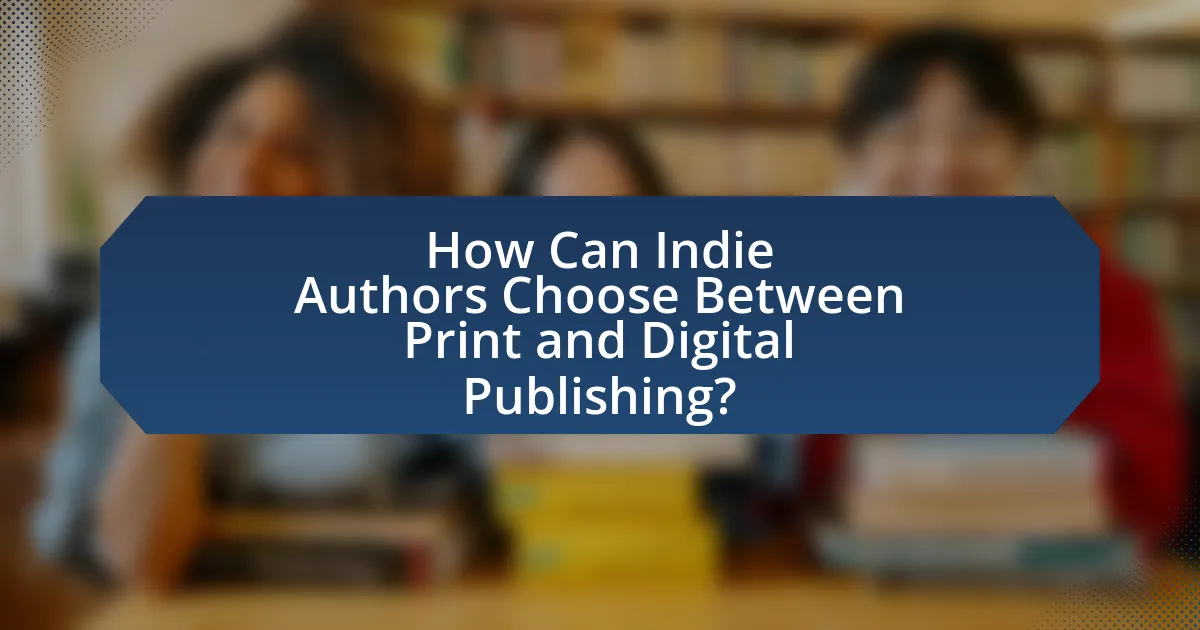
How Can Indie Authors Choose Between Print and Digital Publishing?
Indie authors can choose between print and digital publishing by evaluating their target audience, distribution preferences, and production costs. Print publishing appeals to readers who prefer physical books, while digital publishing caters to those who favor convenience and instant access. According to a 2021 survey by the Independent Book Publishers Association, 70% of readers still enjoy print books, indicating a significant market for physical copies. Conversely, digital formats offer lower production costs and wider distribution through platforms like Amazon Kindle, making them attractive for authors seeking to reach a global audience. By analyzing these factors, indie authors can make informed decisions that align with their goals and audience preferences.
What factors should indie authors consider when deciding on a format?
Indie authors should consider audience preferences, distribution channels, production costs, and marketing strategies when deciding on a format. Audience preferences dictate whether readers favor print or digital formats, influencing the author’s choice. Distribution channels, such as online platforms or bookstores, impact the availability of the chosen format. Production costs vary significantly between print and digital, affecting the author’s budget and pricing strategy. Lastly, marketing strategies differ for each format; digital formats often allow for more dynamic promotional tactics, while print may benefit from local events and signings. These factors collectively guide indie authors in making informed decisions about their publishing format.
How do target audience preferences influence format choice?
Target audience preferences significantly influence format choice by determining which medium—print or digital—will effectively engage readers. For instance, younger audiences often prefer digital formats due to their accessibility and convenience, while older demographics may favor print for its tactile experience and ease of reading. Research indicates that 70% of millennials read e-books, while 60% of seniors still prefer physical books, showcasing a clear divide in preferences that authors must consider when selecting their publishing format. This alignment with audience preferences ensures higher engagement and satisfaction, ultimately impacting sales and readership.
What role does genre play in the decision-making process?
Genre significantly influences the decision-making process for indie authors by guiding their choices in content creation, marketing strategies, and audience targeting. Different genres have distinct conventions, expectations, and readership demographics, which authors must consider to effectively engage their target audience. For instance, a romance novel typically requires a focus on character development and emotional arcs, while a thriller emphasizes pacing and suspense. Understanding these genre-specific elements allows authors to tailor their narratives and promotional efforts, ultimately enhancing their chances of success in both print and digital publishing.
What strategies can indie authors use to effectively combine both formats?
Indie authors can effectively combine print and digital formats by utilizing a multi-channel distribution strategy. This approach allows authors to reach diverse audiences, as print books cater to readers who prefer physical copies, while digital formats appeal to those who enjoy e-books. By leveraging platforms like Amazon for e-books and local bookstores or print-on-demand services for physical copies, authors can maximize their market presence. Additionally, offering exclusive content or bonuses in one format can incentivize readers to purchase both versions, enhancing overall sales. This strategy is supported by the fact that the global e-book market was valued at approximately $18 billion in 2020, indicating a significant demand for digital formats alongside traditional print.
How can authors leverage print and digital formats for maximum reach?
Authors can leverage print and digital formats for maximum reach by utilizing a multi-channel distribution strategy that combines both mediums effectively. By offering their work in print, authors can tap into local bookstores, libraries, and events, which cater to readers who prefer physical books. Simultaneously, digital formats allow authors to reach a global audience through platforms like Amazon Kindle, Apple Books, and social media, where e-books can be easily shared and promoted.
Research indicates that 65% of readers still prefer print books for their tactile experience, while e-books account for over 30% of the book market, highlighting the importance of both formats. By integrating print and digital marketing efforts, such as using social media campaigns to promote print signings or offering exclusive digital content to print buyers, authors can maximize their visibility and engagement across diverse reader demographics.
What are the best practices for marketing across both platforms?
The best practices for marketing across both print and digital platforms include creating a cohesive brand message, utilizing social media for engagement, and leveraging email marketing for direct communication. A cohesive brand message ensures that the author’s identity and book themes resonate consistently across both mediums, enhancing recognition and trust. Social media platforms, such as Facebook and Instagram, allow authors to engage with their audience through interactive content, which can drive traffic to both print and digital sales. Email marketing, with a reported return on investment of $42 for every dollar spent, provides a direct line to readers, allowing for personalized promotions and updates that can effectively boost sales across both formats.
What are the key takeaways for indie authors navigating print and digital publishing?
Indie authors should focus on understanding the distinct advantages and challenges of both print and digital publishing. Print publishing offers tangible products and can appeal to traditional readers, while digital publishing provides broader distribution and lower upfront costs. According to a 2021 survey by the Independent Book Publishers Association, 70% of indie authors reported that digital formats significantly increased their sales reach. Additionally, indie authors must prioritize marketing strategies tailored to each format; for instance, social media campaigns are often more effective for digital releases, while local events can boost print sales. Understanding these dynamics enables indie authors to make informed decisions that enhance their publishing success.
